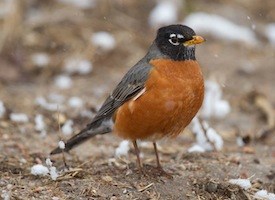Robin
The robin is a small bird, originally found in only Europe and Asia. The robin today can be found across the world in parts of Africa, North America and New Zealand but all of these robin species are believed to be subspecies of the European robin. The European robin has a bright orange/red chest and is the most distinctive bird of the robin family. Despite the bright chest of the European robin, other species of female robin are fairly plain and brown in colour. The female robin is very similar in both size and appearance to the nightingale and the two are commonly confused. The New Zealand robin and the North American robin look fairly similar to the female European robin, and all these robins are brown in colour. The North American robin is not to be confused with the American robin which is actually a member of the thrush family rather than being a species of robin. The American robin is named after the European robin due to it's brightly coloured orange chest. There are thought to be more than 45 different species of robin found on the Australian continent including Australia, Papua New Guinea and numerous other islands in the South Pacific. These birds are known as Australasian robins and are all small sized, with a stocky build and rounded head. Robins are omnivorous birds feeding on a mixture of both plants and animals. The robin primarily eats insects and worms, which it does so by swooping down on them from the perch it has been watching it's prey from. Robins sit on tree branches and in hedgerows watching their prey moving around on the ground before they suddenly fly down to eat. Robins also eat fruits, seeds and berries when they are in abundance during the warmer months of the year. Generally, robins do not migrate (particularly those found in the UK). It is known however, that those robins that inhabit areas within the Arctic circle, such as Scandinavia, do migrate south to the warmer climates of the United Kingdom and parts of Europe to escape the bitterly cold winters. Robins mate in the late winter to early spring. Female robins build a nest not far from the ground generally in trees or dense hedgerows. It is not uncommon however to find robins nesting is slightly strange places such as holes in stone walls and even in letter boxes. The female robin lays 4 or 5 white coloured eggs that hatch after an incubation period of just under 2 weeks. Although the male robin does not help to incubate the eggs, male robins are known to bring the female robins food whilst they are sitting on their nest. When the robin chicks hatch they are a brown colour and do not develop the bright orange chest of their parents until they are older. The female robin regularly leaves her chicks in order to help the male robin collect food. Both parents are known to feed their robin chicks for the first month, although robin families are known to abandon their original nest after two weeks of the chicks hatching and find somewhere new where food is in greater supply. Due to their small size, robins have a number of natural predators in the wild including cats, dogs, foxes, raccoons and even larger birds. Other animals such as rats and snakes are known to eat the eggs of the robin if for some reason the female robin cannot protect them.,,,,,,,,,,,,,,,,,,,,,,,,,,,,,,,,,,,,,,,,,,,,,,,,,,,,
The quintessential early bird, American Robins are common sights on lawns across North America, where you often see them tugging earthworms out of the ground. Robins are popular birds for their warm orange breast, cheery song, and early appearance at the end of winter. Though they’re familiar town and city birds, American Robins are at home in wilder areas, too, including mountain forests and Alaskan wilderness.

No comments:
Post a Comment